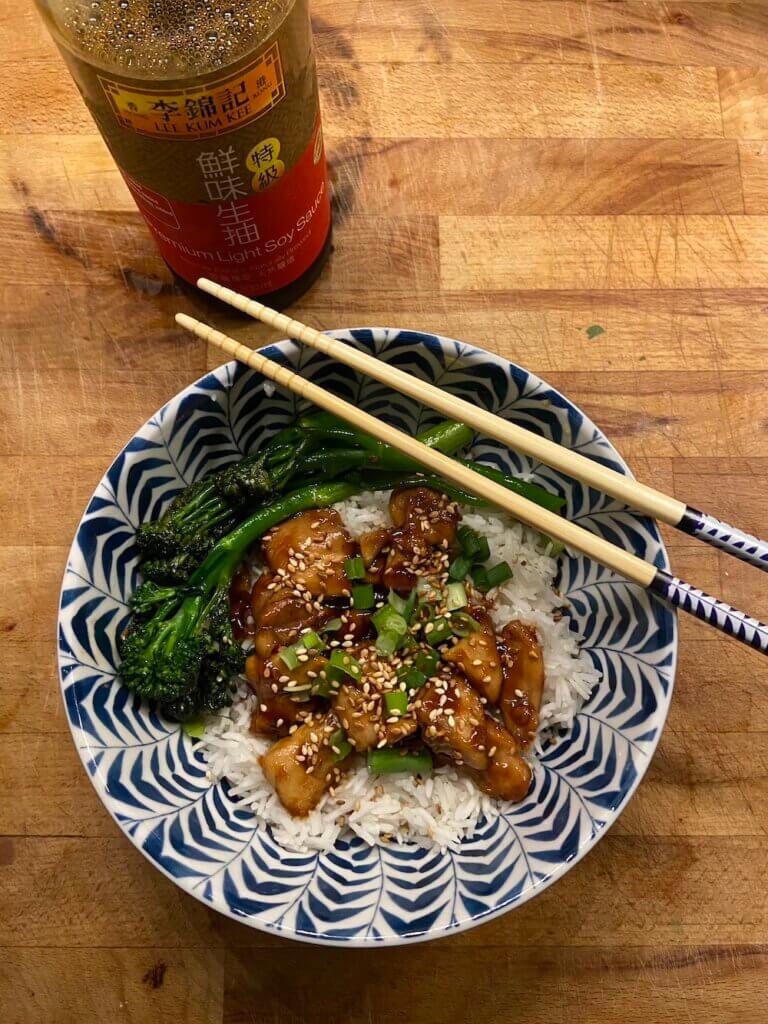Chicken Teriyaki & Tenderstem Broccoli with Rice
This is the Queen Recipe of all recipes: chicken teriyaki with tenderstem broccoli and toasted sesame seeds on a bed of rice, one of the most versatile recipes you’ll ever find. You can substitute and switch pretty much any of the ingredients: switch the chicken for pork, the rice for noodles, the broccoli for courgettes. You can basically have this same dish in 10 different variations and every single one of them is going to be a-ma-zing.
This is going to be the shortest introduction we’ve ever written because this recipe deserves your full attention. We’re going to talk about the importance of mastering sauces further down!

Chicken Teriyaki with Tenderstem Broccoli, Toasted Sesame Seeds and Rice
Equipment
- Wok
- Small Pot
- Pan
Ingredients
For the Teriyaki Sauce
- 1 1/2 cup water
- 70 g brown sugar
- 80 ml soy sauce
- 2 garlic cloves (crushed)
- 1 inch fresh ginger (or 2/3 tsp of ground ginger)
- 1 1/2 tbsp cornflour (dissolved in just enough water to turn it into a nice paste, 1 to 2 tbsp)
- 1 tbsp rice wine vinegar
For the Boiled Rice
- 1 cup basmati rice
- 1 1/2 cup water
For the Chicken and Broccoli
- 2 tbsp vegetable oil
- 500 g chicken thighs
- 100 g tenderstem broccoli
- 2 tbsp sesame seeds
- 4 spring onion (for decoration)
- Salt
- Pepper
Instructions
For the Teriyaki Sauce
- In a small pot, add together the water and sugar. Let the sugar dissolve, and then add the soy sauce, crushed garlic, and ginger.
- Let it cook for 5 to 10 minutes on a medium heat – the sauce should reduce a little.
- Dissolve the cornflour in enough water to turn it into a paste: do not add the cornflour directly to the mix, or it will clump! Once dissolved, add to the small pot and whisk together.
- Add the rice wine vinegar, cook for another 3 to 5 minutes and taste to check if the balance is good for you. You can add more water if the sauce gets too thick, a splash at the time.
For the Boiled Rice (foolproof)
- Rinse your basmati rice thoroughly, until the water comes clean.
- Add to a pot and cover with 1 and 1/2 cups of cold water. It should be enough water to cover your first phalange.
- Bring to a boil over high heat.
- Reduce to a simmer and cover. Let the rice cook for 12 to 15 minutes.
- To check if it's ready, scoop the rice slightly in the center and check if there's any leftover water. If there is, cover and let cook a bit longer. If not, turn the heat off, fluff the rice with a fork and let it stay covered until ready to serve.
For the Chicken and Broccoli
- (optional) If you want to add some toasted sesame seeds, prepare them now to avoid a too-crowded stove. Just put 2 tbsp of sesame seeds on a pan and let toast over medium heat for 2 to 3 minutes or until golden. Move them continuosly so they don't burn!
- Dice your chicken thighs, and add salt and pepper.
- Add half of the vegetable oil to the wok over a high heat and cook the chicken thighs for approximately 5 minutes or until they turn golden.
- Add 3/4 of the teriyaki sauce you made earlier, and mix. Let it cook for another 5 to 10 minutes over medium heat or until the chicken looks glossy.
- In a separate pan, add the remaining vegetable oil and over medium heat. Add the tenderstem broccoli and let cook for 5 minutes. Add the remaining teriyaki sauce to coat them.
- (optional) If you want, chop some spring onions (both green and white bits). Plate the rice, the chicken, the broccoli, and add spring onions and sesame seeds. Dinner is served!
Teriyaki and the importance of a sauce
Sauces are absolutely everything. And I get it, it might sound as if I’m exaggerating a bit but I can promise you I’m not. Despite being closer to my 30s than my 20s, I still have some issues with vegetables, and being able to use dressing such as this teriyaki sauce makes a massive difference for my eating habits.
So let’s analyse this chicken teriyaki for example: with a very, super simple recipe such as this one that includes no more than a handful of ingredients, we managed to get a flavour-packed meal that made our Tuesday night great. Otherwise we would’ve had chicken, broccoli, and rice: just writing it makes me sad, and also reminds of me of my very boring meals when I was at university.
Remember when we talked about the importance of some staple ingredients if you want to explore Asian cuisine? We pretty much used the same exact ones we bought last year and with which we made our award-winning (now I’m getting carried away) Chinese-inspired aglio e olio. We did buy more soy sauce because we go through bottles of soy sauce as if it was fresh water. Everything else we bought and we still use regularly to give a bit of extra flavour to our usual dishes.
Some ingredients might feel scary and intimidating for those of us that are not used to them, and that’s absolutely fine. Fish sauce? A mystery for me until I started occasionally using it: I wrongly assumed that since I don’t like seafood, I would not like fish sauce in my food either. WRONG! Sometimes it’s not about the single ingredient but the final result. Just think of a Bloody Mary as an example: the combination of flavours is so on point that you can’t really spot the vague anchovy flavour coming from the Worchestire sauce. Unless you’re a vegetarian or a vegan, please do me the favour to go and get that fish sauce. It doesn’t smell great, but neither does blue cheese and it seems to me that you’re all obsessed with it anyway.
So if you want to take our advice, go over Asian Grocery UK or your country’s equivalent and buy at least:
- oyster sauce
- fish sauce
- rice wine
- soy sauce (although I have to hope you have this one already)

Know your flavours: spices do make a difference, teriyaki or not
On top of everything I said in the previous paragraph, I’ve learned from the very talented chef Natasha Ho during one of her live videos, sauce and dressings do make the difference and shall not be underestimated, not even for one second. Using the same ingredient (let’s say a normally boring and plain courgette), you can get tons of different cuisines out of if you know how to use your spices. Garam masala is definitely gonna give it a more Indian flavour, lemongrass and coconut milk would verge towards a Thai cuisine, while if you use za’atar you’re gonna get a very Mediterranean and Middle-Eastern flavour. Those are all the flavours that make your takeaway the way it is: familiar, comforting, and delicious.
This is the strategy we use when we cook without necessarily following a recipe or when we’re coming up with our own: after identifying what spices are mostly used in one specific cuisine, we start our process of trial and error. Sometimes we did some very awful experiments that I would never try again if my life depended on it, but that’s also the beauty of it. It’s a matter of learning a few very basic concepts and then applying them to everything else, and it’s a game-changer for your cooking!
